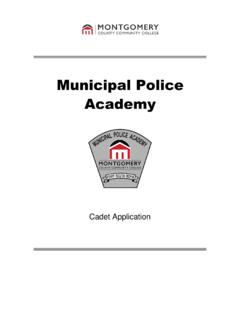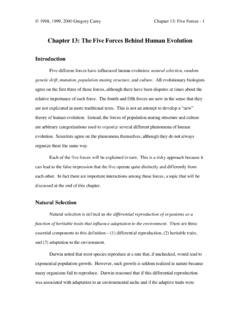Transcription of BIO PLACEMENT TEST REVIEW QUESTIONS Review 1: …
1 1 BIO PLACEMENT TEST REVIEW QUESTIONS REVIEW 1: Answer Key on page 11 Select the correct answer. 1) Which of the following is FALSE about scientific theories? A) They have been thoroughly tested. B) They are developed by inductive reasoning. C) They are used to support observations using deductive reasoning. D) They can be either supported or modified by new observations. E) They are firmly established and cannot be refuted. 2) Which of the following issues would be LEAST helped by application of the scientific method? A) Developing more effective high school curricula B) Evaluating the relationship between violence in videogames and criminal behavior in teens C) Determining the most effective safety products for automobiles D) Formulating public policy on euthanasia E) Comparing the effectiveness of two potential antibiotics 3) In controlled experiments: A) One variable is manipulated while others are held constant B) All variables are dependent on each other C) All variables are held constant D) All variables are independent of each other E) All critical variables are manipulated 4) Which of the following is/are characteristics of living organisms?
2 A) Organized structure B) Growth and reproduction C) Maintenance of homeostasis D) A and B E) A, B and C 5) What do we call the maintenance of internal conditions of an organism within a certain boundary range? A) Evolution B) Homeostasis C) Adaptation D) Metabolism E) Photosynthesis 2 6) Which is the correct sequence of increasing organization? A) Molecule, cell, organelle, organ B) Organelle, tissue, cell, organ C) Atom, molecule, tissue, cell D) Organ, organism, tissue, cell E) Cell, tissue, organ, organ system 7) Which kingdom possesses unicellular animal-like species and unicellular plant-like species? A) Fungi B) Animalia C) Protist D) Plant E) Bacteria 8) The Bacteria and Eukarya domains are distinguished by: A) All members of Bacteria are single-celled and all members of Eukarya are multicellular.
3 B) All Bacteria get nutrients via absorption and all Eukarya by photosynthesis. C) Only Eukarya have the ability to grow and reproduce. D) In Bacteria there is an absence of membranous organelles, such as a nucleus. E) Only Eukarya have DNA 9) A basic difference between a prokaryotic cell and a eukaryotic cell is that the prokaryotic cell: A) Possesses membrane-bound organelles. B) Lacks a nucleus. C) Lacks DNA D) is considerably larger. E) is structurally more complex. 10) The atomic number of carbon is 6. Its nucleus must contain: A) 6 neutrons and 6 protons B) 3 protons and 3 neutrons C) 6 neutrons and 0 electrons D) 6 protons and 0 electrons E) 6 protons and 6 electrons 11) Whic A B C D E 12) A ch A B C D E 13) Wha A) B C D E 14) Whic of te A B C D E ch of theseA) Carbon B) HydrogenC) PhosphoD) Calcium E) All of the hemical comA) A proton B) A base C) An acid D) A hydroxE) A hydrogat happens ) The HCl mB) The wateC) The concD) The pH oE) None of tch propertyemperatureA) High specB) High heaC) High heaD) A and B E) A, B, and atoms woun rus above mpound thaide ion en ion when hydrmolecules ser had less fcentration oof the waterthe above y of water me for living ocific heat t of vaporizt of fusion d C uld becomeat releases ochloric acseparate intfree H+ of OH- increr increasesmolecules eorganisms?
4 Zation e inert if it aOH- into a sid is addedto H+ and Ceases enables wat accepted thsolution is cd to water?Cl- ter to functiree electroncalled: on as a mons? oderator 3 15) The A B C D E 16) A co A) B C D E 17) Wha into A B C D E formation oA) Gain or loB) Gain or loC) Sharing oD) Sharing oE) Gain or loovalent bon) Two non-pB) A positiveC) One atomD) Two atomE) Two polaat type of ch their respeA) CondensB) HydrolysiC) OxidationD) IonizationE) Dehydratof ions invooss of electoss of protoof electronsof protons oss of neutrd is formedpolar molecely chargedm gives up ems share elr moleculeshemical reaective subuation is n n tion olves the: trons ons s rons d when: cules assocd particle is electrons toectrons s are attracaction resulnits? ciate with eattracted too another acted to eachts in the breach other io a negativatom h other eakdown o n a polar envely chargedf organic ponvironmentd particle olymers 4 t 5 18) As shown in this figure, the top triglyceride (a) has ____; the bottom triglyceride has ____.
5 A) Double bonds and is saturated; no double bonds and is unsaturated B) No double bonds and is saturated; double bonds and is unsaturated C) No double bonds and is unsaturated; double bonds and is saturated D) Double bonds and is unsaturated; double bonds and is unsaturated E) Double bonds and is unsaturated; no double bonds and is saturated 19) Which of the following reactions requires the removal of water to form a covalent bond? A) Glycogen -> glucose subunits B) Peptide -> amino acids C) Cellulose -> glucose D) Glucose and galactose -> lactose E) Fat -> fatty acids and glycerol 20) Which of the following refers to the amino acid sequence of proteins? A) Primary B) Secondary C) Tertiary D) Quaternary E) None of the above 21) Which is not a feature of a prokaryotic cell? A) A plasma membrane B) A nuclear membrane C) Ribosomes D) Enzymes E) DNA 22) After being formed by ribosomes on the endoplasmic reticulum, what is the next organelle to which a protein might be transported?
6 A) Mitochondria B) Smooth endoplasmic reticulum C) Nucleus D) Golgi apparatus E) Chloroplast 23) Which type of cell does NOT produce cell walls? A) Animal cells B) Plant cells C) Archaea D) Bacteria E) Prokaryotic cells 6 24) In an experiment, you measure the concentration of a polar molecule inside and outside the cell and find that the concentration of this molecule is gradually increasing inside the cell. You also measure the concentration of ATP inside the cell and find that it is dropping. Which of the following processes are you likely to be observing? A) Osmosis B) Facilitated diffusion C) Active Transport D) Simple diffusion E) Passive transport 25) The movement of water across a membrane from a solution of lower solute concentration to a solution of higher solute concentration is best described as A) Osmosis B) Facilitated diffusion C) Active Transport D) Simple diffusion E) Endocytosis 26) Mitochondria and chloroplasts share all of the following characteristics EXCEPT that they: A) Are capable of ATP synthesis.
7 B) Capture the energy of sunlight to meet metabolic demands. C) Possess their own DNA D) Are surrounded by a double membrane E) Were originally independent organisms 27) Which of the following will be least likely to degrade a protein? A) Temperature greater than 100 degrees centigrade B) Strong acid C) Strong base D) Water E) Poisons 28) Which of the following energy-generating processes is the only one that occurs in almost all living organisms? A) Glycolysis B) Combustion C) Krebs Cycle D) Photosynthesis E) Chemiosmosis 7 29) At the end of glycolysis, the original carbons of the glucose molecule form: A) Six molecules of carbon dioxide B) Two molecules of NADH C) Two molecules of pyruvate D) Two molecules of citric acid E) Two molecules of fructose 30) The oxygen we breathe in is used in A) Glycolysis B) Krebs cycle C) Electron Transport System D) Preparatory Step E) Fermentation 31) If a DNA sample contains 13% adenine, what percentage of the sample contains cytosine?
8 A) 13% B) 0% C) 37% D) 26% E) 74% 32) For the DNA sequence G-C-C-T-A-T in one polynucleotide chain, the sequence found in the other polynucleotide chain must be: A) C-G-G-A-T-A. B) G-C-C-A-T-A. C) C-G-G-A-U-A. D) A-T-T-C-G-C. E) G-C-C-T-A-T. 33) Which of the following are expected to result in genetic variation among offspring? A) Mutations B) Crossing over C) Random assortment of parental chromosomes during meiosis D) A and B E) A, B, and C 34) For a mutation to affect the evolution of an animal species, it must occur in A) Somatic cells B) Prokaryotic cells C) Gametes D) None of the above E) All of the above 8 35) If a sperm cell has 6 chromosomes, it comes from an animal whose somatic cells have ___ chromosomes.
9 A) 6 B) 10 C) 12 D) 18 E) 24 36) The haploid number of chromosomes for humans is *A) 23 B) 24 C) 26 D) 46 E) 48 37) Which represents the correct sequence of stages in the cell cycle? A) G1, G2, S, M B) G1, G2, M, S C) M, S, G1, G2 D) G1, S, G2, M E) G1, M, G2, S 38) Which of the following is TRUE regarding the genetic information in the cells of your body? A) Different kinds of body cells contain different genetic information. B) Each type of body cell contains only the genetic information it needs to be that type of cell. C) The genetic information in almost all of your body cells is identical. D) The genetic information in your body cells changes in a predictable manner as you grow and develop.
10 E) The genetic information is stored in the sequence of amino acids in proteins 39) What is the importance of crossing over in meiosis? A) It provides extra genetic material for the daughter cells B) It produces proteins necessary for cell division C) It causes the separation of homologous chromosomes D) It ensures that the daughter cells have different genetic material E) It initiates meiosis 11 40) At which stage of meiosis is each chromosome composed of a single chromatid? A) Prophase 1 B) Prophase 11 C) Metaphase 1 D) Metaphase 11 E) Anaphase 11 9 41) Which of the classes of RNA molecules carries the genetic information as it is needed for the construction of a protein? A) Ribosomal RNA B) Transfer RNA C) Messenger RNA D) Primary RNA E) Secondary RNA 42) Which the following occurs in the nucleus in a eukaryotic cell? A) Transcription only B) Assembly of amino acids into protein only C) Replication of genetic material only D) Both transcription and replication of genetic material E) Translation only 43) What are alleles?





